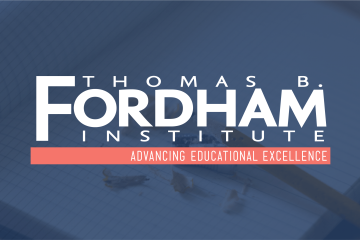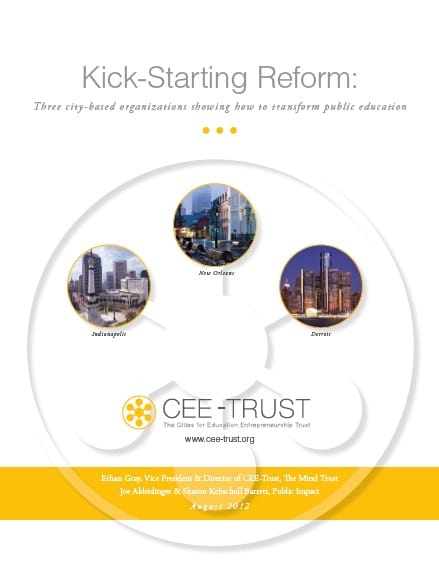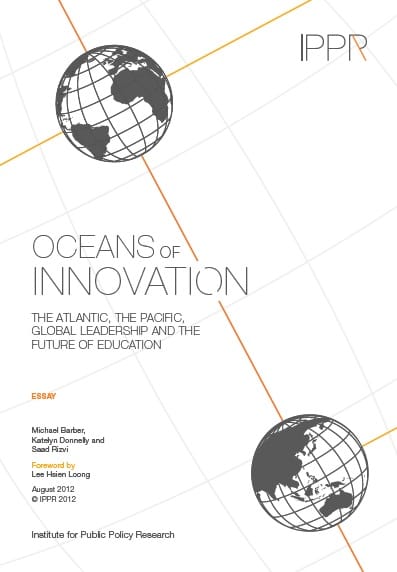
Kick-Starting Reform: Three City-Based Organizations Showing How to Transform Public Education
Local control, education-advocacy style

Local control, education-advocacy style














 With a string of state-level victories behind us, much of the school-reform action is shifting to the local level. Enter the Cities for Education Entrepreneurship Trust (CEE-Trust), a fast-growing network of local foundations, nonprofits, and mayors’ offices committed to edu-reform. (Fordham is proud to be a policy partner.) This new report from CEE-Trust profiles three of its members: The Mind Trust (Indianapolis), New Schools for New Orleans (NSNO), and the Skillman Foundation (Detroit)—offering keen, concrete, and constructive insights into how each worked within their unique local contexts to leverage funding and resources and attract talent to their cities. NSNO, for example, invested specifically in “talent providers” like TNTP, New Leaders for New Schools, and TeachNOLA; The Mind Trust created an entrepreneurial fellowship and a venture fund to bring innovative people and ideas to Indy; and Skillman fostered community engagement through the Detroit Parent Network. The three organizational histories in the report deliver valuable lessons and perilous alerts for likeminded city-based education-reform organizations; the overall recommendations at the end of the report are worthwhile as well. While there is no “perfect customized strategy,” as CEE-Trust acknowledges, these three experiences offer a viable template for other organizations angling to play a similar role in their respective cities.
With a string of state-level victories behind us, much of the school-reform action is shifting to the local level. Enter the Cities for Education Entrepreneurship Trust (CEE-Trust), a fast-growing network of local foundations, nonprofits, and mayors’ offices committed to edu-reform. (Fordham is proud to be a policy partner.) This new report from CEE-Trust profiles three of its members: The Mind Trust (Indianapolis), New Schools for New Orleans (NSNO), and the Skillman Foundation (Detroit)—offering keen, concrete, and constructive insights into how each worked within their unique local contexts to leverage funding and resources and attract talent to their cities. NSNO, for example, invested specifically in “talent providers” like TNTP, New Leaders for New Schools, and TeachNOLA; The Mind Trust created an entrepreneurial fellowship and a venture fund to bring innovative people and ideas to Indy; and Skillman fostered community engagement through the Detroit Parent Network. The three organizational histories in the report deliver valuable lessons and perilous alerts for likeminded city-based education-reform organizations; the overall recommendations at the end of the report are worthwhile as well. While there is no “perfect customized strategy,” as CEE-Trust acknowledges, these three experiences offer a viable template for other organizations angling to play a similar role in their respective cities.
SOURCE: Ethan Gray, Joe Ableidinger, and Sharon Kebschull Barrett, Kick-Starting Reform: Three City-Based Organizations Showing How to Transform Public Education (Indianapolis, IN: CEE-Trust, August 2012).

“No excuses” charter schools have shown themselves to be immensely successful at educating low-income and minority students. But how successful have they been at preparing these youngsters for the rigors of college? This American RadioWorks documentary profiles the YES Prep charter network in Houston, which is wrestling with that exact question. YES Prep runs eleven sixth through twelfth grade schools, serving 7,000 students in Space City. The charter network boasts a 100 percent four-year college-acceptance rate—but only a 40 percent college-graduation rate, which has YES Prep staffers confused. Their students all take AP courses—and pass them at rates over double the national average. The school's curricula seems like it should prepare graduates for college. YES Prep staffers are now investigating the role that “grit”—the willingness to work harder and longer than most others would consider rational—may play in determining college success. They found, for example, that those who most struggled in their YES Prep schools fared the best when they got to college, showing that academic perseverance may matter more than innate smarts. Documentarian Emily Hanford also reminds us, however, that these students may have also succeeded because they were able—and knew how—to find and receive help on a college campus. The documentary asks more questions than it answers, about the right balance between knowledge and perseverance and between grit and the willingness to ask for help. But they are important questions indeed.
RELATED ARTICLE: Emily Hanford, Grit Luck and Money Preparing Kids for College and Getting Them Through (St. Paul, MN: American RadioWorks, August 2012).

 Despite economic and educational premonitions, the twenty-first century does not inevitably belong to the Asian or Pacific nations. In this lengthy essay, Sir Michael Barber and colleagues explain how these nations must revamp their education systems to ensure continued growth and competitive edge. (Presumably the essay’s lessons would benefit the U.S. and other Atlantic nations as well, but those are not the targeted audiences for this piece.) Barber and his colleagues find innovation to be the doorway to twenty-first century global leadership. Yet, as they state, “this philosophy of everyone as an entrepreneur and innovator is not what underpins education anywhere in the world right now.” To unlock this potential, Barber calls for systemic reforms to current Pacific education systems: On the governance front, he pushes for an end to top-down bureaucracies that stymie innovation, the creation of autonomous schools, and private-school growth. He calls for strong academic standards for all (though he wades dangerously into the sullied waters of “twenty-first century skills” acquisition when doing so). He urges schools not to neglect the educations of their best and brightest. And he warns that, without prudent and thoughtful implementation, these would-be dramatic shifts will fizzle. Barber also laces the text with concrete examples of successful systemic shifts. But one has to wonder, why target this advice to the Pacific nations? Many in the U.S. are receptive, indeed eager, to heed it too.
Despite economic and educational premonitions, the twenty-first century does not inevitably belong to the Asian or Pacific nations. In this lengthy essay, Sir Michael Barber and colleagues explain how these nations must revamp their education systems to ensure continued growth and competitive edge. (Presumably the essay’s lessons would benefit the U.S. and other Atlantic nations as well, but those are not the targeted audiences for this piece.) Barber and his colleagues find innovation to be the doorway to twenty-first century global leadership. Yet, as they state, “this philosophy of everyone as an entrepreneur and innovator is not what underpins education anywhere in the world right now.” To unlock this potential, Barber calls for systemic reforms to current Pacific education systems: On the governance front, he pushes for an end to top-down bureaucracies that stymie innovation, the creation of autonomous schools, and private-school growth. He calls for strong academic standards for all (though he wades dangerously into the sullied waters of “twenty-first century skills” acquisition when doing so). He urges schools not to neglect the educations of their best and brightest. And he warns that, without prudent and thoughtful implementation, these would-be dramatic shifts will fizzle. Barber also laces the text with concrete examples of successful systemic shifts. But one has to wonder, why target this advice to the Pacific nations? Many in the U.S. are receptive, indeed eager, to heed it too.
SOURCE: Michael Barber, Katelyn Donnelly, and Saad Rizvi, Oceans of Innovation: The Atlantic, the Pacific, Global Leadership and the Future of Education (London, England: Institute for Public Policy Research, 2012).

Mike and Dara look at how the two parties’ education platforms compare and ask what it would take to shake up special education. Amber analyzes a decidedly unscientific look at education policy.
August 2012 Education Insider: Presidential Election by Whiteboard Advisors - Download PDF

Mike Petrilli and Ty Eberhardt discuss the soft spots in President Obama's education record.
For a more in depth view at the president's education record, please read the article on Education Next.

The Democratic National Convention will wrap up tonight, likely with a shower of balloons and a call for solidarity from President Obama, as the campaign enters its final phase. Solidarity was anything but apparent on Monday, however, at a showing of the controversial film “Won’t Back Down.” DNC delegates who attended passed parents and teachers who picketed outside on their way to listening to uber-reformer Michelle Rhee discuss the movie inside. The screening of the Hollywood tribute to the “parent trigger” had the blessing of the White House and party higher ups, but certainly not of the AFT’s Randi Weingarten and others in the Democrats’ traditional labor base also in Charlotte this week. As Rhee pointed out, “There is no longer sort of this assumed alliance between the Democratic Party and the teachers unions.” With a strike that would pit a Democratic mayor (and Obama’s former chief-of-staff) against the Chicago Teachers Union looming next week, the uneasy Democratic alliance over education issues will only be strained further. It seems that a week after Republicans signaled that they had found their way on education, Democrats took one step closer to coming apart over the issue.
RELATED ARTICLE: “Teachers unions’ alliance with the Democratic Party frays,” Los Angeles Times, September 3, 2012.

The premise of Paul Tough’s excellent new book, How Children Succeed: Grit, Curiosity, and the Hidden Power of Character—that cognitive ability matters, but character traits like tenacity, curiosity, and optimism matter more—is a strong challenge to my long-held notion that, when students struggle, whether in high school or college, much of that is attributable to their lack of academic preparedness. How Children Succeed largely argues otherwise, but there is a brief but fascinating account late in the book that suggests we shouldn’t be too quick to worship at the altar of grit alone.
 Is school just like chess? Perhaps not. Photo by Adam Raoof. |
The first half of Tough’s book unpacks clinical research that demonstrates the importance of parents protecting children from adversity in the first years of life. But it is the ability to persist in difficult tasks that ultimately seems to lead to success. Tough’s book, broadly speaking, makes the case that, insofar as there is any formula for success in life, it starts with a child’s need for protective, nurturing parenting, followed by independence and challenge to develop resiliency and “grit.”
A chapter entitled “How to Think” describes in vivid detail the remarkable success of the chess team at IS 318 in Brooklyn, New York and the uncompromising approach of teacher Elizabeth Spiegel. At the end of the chapter, she takes on the challenge of preparing James Black, one of her star chess players, for New York City’s specialized high school test—the entrance exam for Stuyvesant, Bronx Science, and other super-elite public secondary schools. Under Spiegel’s tutelage, James, an African American boy from Brooklyn’s Bedford-Stuyvesant neighborhood, had become a national chess champion and achieved “master” status in the game, one of only three African-American masters under age thirteen.
Wrong. By mid-July, Tough writes, James’s progress was minimal. Still, his teacher tried to keep him motivated:
Is school just like chess? Perhaps not. UVA cognitive scientist Dan Willingham points out that, at the elite level, chess becomes in part an exercise in memory. You and I look at a chess board and must painstakingly evaluate endless permutations of attacks and counter attacks as we try to think several moves ahead. James and other masters see patterns. “For some kids their learning curve is rapid. They get good quickly in ways that most people do not,” says Willingham.
But broad, general knowledge is different, Willingham notes. “Academic knowledge and skills are wide ranging and accumulate over a very long time.” It is nearly impossible to “get good quickly.” Spiegel's principal might have been exactly right.
Tough writes that James “represented for me (and for Spiegel, I suspect), a challenging puzzle. Here was a young man clearly possessed of a keen intelligence. (Whatever intelligence means, you can’t beat Ukrainian grand masters without plenty of it.) And he seemed to be a case study in grit.” Yet despite his own and his teacher’s clear and obvious efforts, James failed to win entry into Stuyvesant, New York’s most selective high school, whose best chess players, Tough ruefully notes, James “will no doubt crush.” Why?
“The specialized high-school exam is, by design, difficult to cram for,” Tough writes. “Like the SAT, it reflects the knowledge and skills that a student has accrued over the years, most of which is absorbed invisibly throughout childhood from one’s family and culture.” [emphasis added]
Tough is undoubtedly correct that much essential knowledge is indeed family driven. There are clear benefits to growing up in a home filled with books and college-educated parents who engage their children in rich dinner-table conversation, museum visits, travel, and other enriching cultural experiences. But even without knowing a thing about James’s schooling, it’s not hard to surmise that Spiegel is precisely right. James should have learned more and it’s his failure to accrue a young lifetime’s worth of academic content, background knowledge, and vocabulary—not his grit or raw intellectual talents—that likely doomed his effort to get into Stuyvesant.
Family background matters. But it doesn’t follow that schools cannot or should not make a concerted effort from the very first days of Kindergarten to provide as much rich content knowledge across the curriculum as kids need to be successful. This is especially true for “school-dependent” learners who are less likely to be exposed to it, like second-hand smoke, through their daily lives, contact with educated adults, or via what the renowned sociologist Annette Laureau termed “concerted cultivation.” Paul Tough hints at this when he observes,
Right.
Paul Tough has written an outstanding book, and one that will no doubt be deeply influential on parents and educators, and deservedly so. But I fear the takeaway—through no fault of Tough’s—will be “it’s all about character” or “grit trumps cognitive ability.” Not quite right. As James’s experience shows, grit matters a lot, but it’s not sufficient to compensate for a lack of knowledge if we expect kids to clear the high academic bars we place in front of them.
Robert Pondiscio is vice president of the Core Knowledge Foundation. A version of this editorial was originally published on the Core Knowledge blog.

In November 2010, U.S. Education Secretary Arne Duncan presciently observed that, in coming years, educators would “face the challenge of doing more with less,” but warned against discouragement: “Enormous opportunities for improving the productivity of our education system lie ahead if we are smart, innovative, and courageous in rethinking the status quo.” The budget challenges Mr. Duncan foresaw are now reality: States and districts face tough decisions about education spending as revenue declines and federal stimulus spending dries up. But officials who have attempted to do more with less have often found themselves stymied in one key area by the intransigence of the very agency that Mr. Duncan leads.
 Special-education spending is consuming an ever-growing slice of schol budgets. Photo by Dinner Series. |
The roadblock? A federal “maintenance of effort” (MOE) requirement in the Individuals With Disabilities Act (IDEA, the federal special-education law) that handcuffs states and districts by requiring that special-ed spending never decline from one year to the next. In times of plenty, this mandate discourages efforts to make productivity gains; when revenues shrink, it means that special-education spending will consume an ever-growing slice of school budgets.
For one brief shining moment, Secretary Duncan appeared ready to end the MOE silliness. Then he caved to the powerful special-education lobby, which refused to accept anything other than expenditures escalating into perpetuity.
While economic realities alone should be reason enough to jettison requirements that dictate a spend-spend-spend approach to special ed, a new Fordham study by Nathan Levenson provides an even more compelling reason for doing away with MOE: Spending more on special ed simply may not do much for kids.
How is this possible? While public education is never very hospitable to innovation, efficiency, or productivity boosters, special education has generally been downright hostile. Despite statutory and regulatory tweaks from time to time, our approach hasn’t really changed since the federal law was passed more than thirty-five years ago, even as so much else in K–12 education has changed in important ways. That does not, regrettably, mean our traditional approach has worked well. Indeed, change is desperately needed in this corner of the K–12 world, as any look at the (woeful) achievement data or (skyrocketing) spending data for special-needs students demonstrates. To oversimplify just a bit, general (i.e., “regular”) education is now focused on academic outcomes, but special education remains fixated on inputs, ratios, and services.
That’s a shame, since the same basic dysfunctions that ail general education afflict special education too: middling (or worse) teacher quality; an inclination to throw “more people” at any problem; a reluctance to look at cost-effectiveness; a crazy quilt of governance and decision-making authorities; a tendency to add rather than replace or redirect; and a full-on fear of results-based accountability. Yet the fates (as well as the budgets) of general and special education are joined. In many schools, the latter is the place to stick the kids who have been failed by the former—a major cause of the sky-high special-education-identification rates in many states and districts. Further, there exists in many locales the unrealistic expectation that every neighborhood (and charter) school should be able to serve every youngster with special needs at a high level.
 Download Fordham's latest report, Boosting the Quality and Efficiency of Special Education. |
Enter Levenson, former superintendent of the Arlington (MA) Public Schools. In his new study, Boosting the Quality and Efficiency of Special Education, he and his team identified school districts that get similar (or superior) results for special-education students as their peer districts, yet do so at significantly lower cost. They are doing right by kids and right by the bottom line. Both at once. And their practices are eminently imitate-able.
Levenson & co. also developed a national database on special-ed spending—the largest and most detailed ever built. It contains information from almost 1,500 districts, representing 30 percent of U.S. schoolchildren. The database shows that special-education spending and staffing vary wildly—much more so than it does for regular education. Principally driving this variation are huge district-to-district differences in staffing levels.
Some districts hire almost three times more special-ed teachers (per thousand students) than do others. The difference for paraprofessionals (teachers’ aides) is greater than four times. Levenson calculates that, if the high-spending districts adjusted their staffing levels in line with national norms, the country could save (or redirect) $10 billion annually. That’s not chump change! For example, it’s more than twice the total sums invested (over multiple years) in Race to the Top.
The potential for additional savings—and better services for kids—is greater still. To its discredit, longstanding federal law bars the teams that develop Individualized Education Programs for disabled pupils from considering the cost of the interventions and services that they are recommending. Untangling federal barriers to efficiency and effectiveness in special education is the job of Congress—yet no one in Washington seems the least bit interested in tackling an IDEA reauthorization anytime soon. That’s a huge mistake.
Levenson draws on his research to offer a few simple, but assuredly not simplistic, solutions. Make general education better, he says, so that fewer kids get directed into special education. Once youngsters are in special education, design interventions for them that take cost-effectiveness into account—a benefit both for the kids and for the taxpayer. Focus on recruiting better teachers, not more teachers (and aides, specialists, etc.)—for general and special education alike. And scrupulously manage their caseloads.
Districts and states should take these lessons to heart, but the simplest fix supported by Levenson’s findings must occur at the federal level: End maintenance-of-effort requirements that are both inefficient and ineffective. As special-education costs eat into general-education coffers—a trend that is almost certain to continue in the lean years ahead—we suspect that education leaders, policymakers, and taxpayers alike (maybe even the parents and teachers of children with disabilities), will feel impelled to make our perplexing and inefficient special-education system a little less so.

 California legislators abandoned a bill that would have overhauled state rules on teacher evaluations and reduced the role of test scores in them. Apparently the California teacher union's power has limits after all—and Golden State children get to enjoy the benefits of them.
California legislators abandoned a bill that would have overhauled state rules on teacher evaluations and reduced the role of test scores in them. Apparently the California teacher union's power has limits after all—and Golden State children get to enjoy the benefits of them.
As school starts around the country, students are more likely to be taught by rookies than ever before. The cause is a rising teacher attrition rate: Forty to fifty percent of new teachers are likely to leave the profession within five years. How high must turnover rates go before districts, unions, and the public realize that compensation systems stacked in favor of veteran educators through rich retirement benefits and seniority-based pay scales do little to keep the next generation of teachers in classrooms?
Students and educators in Hong Kong are protesting a new curriculum they say is intended to brainwash children into supporting the Chinese government. This episode offers a good example of what many conservatives fear from a national curriculum—and how little the Common Core resembles such a curriculum, despite what critics claim.
Teach For America corps members started work in Ohio the same week that the New York Times hosted a Room for Debate on whether TFA actually works. The status quo certainly doesn't and getting bright young people invested in Ohio's education challenges may help build the foundation for long-term education progress in the Buckeye State.

Mike Petrilli and Ty Eberhardt discuss the soft spots in President Obama's education record.
For a more in depth view at the president's education record, please read the article on Education Next.

Mike Petrilli and Ty Eberhardt discuss the soft spots in President Obama's education record.
For a more in depth view at the president's education record, please read the article on Education Next.

 With a string of state-level victories behind us, much of the school-reform action is shifting to the local level. Enter the Cities for Education Entrepreneurship Trust (CEE-Trust), a fast-growing network of local foundations, nonprofits, and mayors’ offices committed to edu-reform. (Fordham is proud to be a policy partner.) This new report from CEE-Trust profiles three of its members: The Mind Trust (Indianapolis), New Schools for New Orleans (NSNO), and the Skillman Foundation (Detroit)—offering keen, concrete, and constructive insights into how each worked within their unique local contexts to leverage funding and resources and attract talent to their cities. NSNO, for example, invested specifically in “talent providers” like TNTP, New Leaders for New Schools, and TeachNOLA; The Mind Trust created an entrepreneurial fellowship and a venture fund to bring innovative people and ideas to Indy; and Skillman fostered community engagement through the Detroit Parent Network. The three organizational histories in the report deliver valuable lessons and perilous alerts for likeminded city-based education-reform organizations; the overall recommendations at the end of the report are worthwhile as well. While there is no “perfect customized strategy,” as CEE-Trust acknowledges, these three experiences offer a viable template for other organizations angling to play a similar role in their respective cities.
With a string of state-level victories behind us, much of the school-reform action is shifting to the local level. Enter the Cities for Education Entrepreneurship Trust (CEE-Trust), a fast-growing network of local foundations, nonprofits, and mayors’ offices committed to edu-reform. (Fordham is proud to be a policy partner.) This new report from CEE-Trust profiles three of its members: The Mind Trust (Indianapolis), New Schools for New Orleans (NSNO), and the Skillman Foundation (Detroit)—offering keen, concrete, and constructive insights into how each worked within their unique local contexts to leverage funding and resources and attract talent to their cities. NSNO, for example, invested specifically in “talent providers” like TNTP, New Leaders for New Schools, and TeachNOLA; The Mind Trust created an entrepreneurial fellowship and a venture fund to bring innovative people and ideas to Indy; and Skillman fostered community engagement through the Detroit Parent Network. The three organizational histories in the report deliver valuable lessons and perilous alerts for likeminded city-based education-reform organizations; the overall recommendations at the end of the report are worthwhile as well. While there is no “perfect customized strategy,” as CEE-Trust acknowledges, these three experiences offer a viable template for other organizations angling to play a similar role in their respective cities.
SOURCE: Ethan Gray, Joe Ableidinger, and Sharon Kebschull Barrett, Kick-Starting Reform: Three City-Based Organizations Showing How to Transform Public Education (Indianapolis, IN: CEE-Trust, August 2012).

“No excuses” charter schools have shown themselves to be immensely successful at educating low-income and minority students. But how successful have they been at preparing these youngsters for the rigors of college? This American RadioWorks documentary profiles the YES Prep charter network in Houston, which is wrestling with that exact question. YES Prep runs eleven sixth through twelfth grade schools, serving 7,000 students in Space City. The charter network boasts a 100 percent four-year college-acceptance rate—but only a 40 percent college-graduation rate, which has YES Prep staffers confused. Their students all take AP courses—and pass them at rates over double the national average. The school's curricula seems like it should prepare graduates for college. YES Prep staffers are now investigating the role that “grit”—the willingness to work harder and longer than most others would consider rational—may play in determining college success. They found, for example, that those who most struggled in their YES Prep schools fared the best when they got to college, showing that academic perseverance may matter more than innate smarts. Documentarian Emily Hanford also reminds us, however, that these students may have also succeeded because they were able—and knew how—to find and receive help on a college campus. The documentary asks more questions than it answers, about the right balance between knowledge and perseverance and between grit and the willingness to ask for help. But they are important questions indeed.
RELATED ARTICLE: Emily Hanford, Grit Luck and Money Preparing Kids for College and Getting Them Through (St. Paul, MN: American RadioWorks, August 2012).

 Despite economic and educational premonitions, the twenty-first century does not inevitably belong to the Asian or Pacific nations. In this lengthy essay, Sir Michael Barber and colleagues explain how these nations must revamp their education systems to ensure continued growth and competitive edge. (Presumably the essay’s lessons would benefit the U.S. and other Atlantic nations as well, but those are not the targeted audiences for this piece.) Barber and his colleagues find innovation to be the doorway to twenty-first century global leadership. Yet, as they state, “this philosophy of everyone as an entrepreneur and innovator is not what underpins education anywhere in the world right now.” To unlock this potential, Barber calls for systemic reforms to current Pacific education systems: On the governance front, he pushes for an end to top-down bureaucracies that stymie innovation, the creation of autonomous schools, and private-school growth. He calls for strong academic standards for all (though he wades dangerously into the sullied waters of “twenty-first century skills” acquisition when doing so). He urges schools not to neglect the educations of their best and brightest. And he warns that, without prudent and thoughtful implementation, these would-be dramatic shifts will fizzle. Barber also laces the text with concrete examples of successful systemic shifts. But one has to wonder, why target this advice to the Pacific nations? Many in the U.S. are receptive, indeed eager, to heed it too.
Despite economic and educational premonitions, the twenty-first century does not inevitably belong to the Asian or Pacific nations. In this lengthy essay, Sir Michael Barber and colleagues explain how these nations must revamp their education systems to ensure continued growth and competitive edge. (Presumably the essay’s lessons would benefit the U.S. and other Atlantic nations as well, but those are not the targeted audiences for this piece.) Barber and his colleagues find innovation to be the doorway to twenty-first century global leadership. Yet, as they state, “this philosophy of everyone as an entrepreneur and innovator is not what underpins education anywhere in the world right now.” To unlock this potential, Barber calls for systemic reforms to current Pacific education systems: On the governance front, he pushes for an end to top-down bureaucracies that stymie innovation, the creation of autonomous schools, and private-school growth. He calls for strong academic standards for all (though he wades dangerously into the sullied waters of “twenty-first century skills” acquisition when doing so). He urges schools not to neglect the educations of their best and brightest. And he warns that, without prudent and thoughtful implementation, these would-be dramatic shifts will fizzle. Barber also laces the text with concrete examples of successful systemic shifts. But one has to wonder, why target this advice to the Pacific nations? Many in the U.S. are receptive, indeed eager, to heed it too.
SOURCE: Michael Barber, Katelyn Donnelly, and Saad Rizvi, Oceans of Innovation: The Atlantic, the Pacific, Global Leadership and the Future of Education (London, England: Institute for Public Policy Research, 2012).